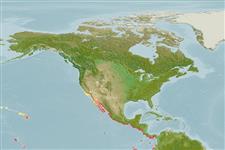Environment: milieu / climate zone / depth range / distribution range
Écologie
marin; eau douce; saumâtre démersal; pH range: 7.5 - 9.5; amphidrome (Ref. 51243); profondeur 1 - ? m. Subtropical; 25°C - 33°C (Ref. 36880); 41°N - 0°S
Eastern Pacific: Palos Verdes in southern California, USA to Peru.
Length at first maturity / Taille / Poids / Âge
Maturity: Lm ?, range 17 - ? cm
Max length : 41.0 cm TL mâle / non sexé; (Ref. 5404); 39.0 cm TL (female); common length : 25.0 cm TL mâle / non sexé; (Ref. 55763); poids max. publié: 1.2 kg (Ref. 5404); poids max. publié: 1.2 kg
Body compressed; head flat; first dorsal fin with 7 spines, second with 1 spine and 8 to 9 rays; anal fin with 1 spine and 9 to 10 rays; lateral line with 30 to 34 scales; body depth contained about three times in standard length; body dark green to dark brown with numerous small pale spots (Ref. 55763).
Facultative air-breathing (Ref. 126274); Inhabit estuaries, stagnant ditches or creeks of low current velocity between the sea and an elevation of 30 m. Benthic and most abundant on sandy and muddy bottoms. Ingests much mud and detritus, although also filter plankton (Ref. 36880). Found in shallow inshore areas; typically in freshwater but moves freely into the sea.
Life cycle and mating behavior
Maturité | Reproduction | Frai | Œufs | Fécondité | Larves
Eschmeyer, W.N., E.S. Herald and H. Hammann, 1983. A field guide to Pacific coast fishes of North America. Boston (MA, USA): Houghton Mifflin Company. xii+336 p. (Ref. 2850)
Statut dans la liste rouge de l'IUCN (Ref. 130435)
Menace pour l'homme
Harmless
Utilisations par l'homme
Pêcheries: commercial; Aquaculture: commercial
Plus d'informations
RéférencesAquacultureProfil d'aquacultureSouchesGénétiqueElectrophoresesHéritabilitéPathologiesTraitementNutrientsMass conversion
Outils
Articles particuliers
Télécharger en XML
Sources Internet
Estimates based on models
Preferred temperature (Ref.
123201): 22.3 - 29.1, mean 26.8 °C (based on 208 cells).
Phylogenetic diversity index (Ref.
82804): PD
50 = 0.5312 [Uniqueness, from 0.5 = low to 2.0 = high].
Bayesian length-weight: a=0.01072 (0.00781 - 0.01470), b=3.11 (3.02 - 3.20), in cm total length, based on LWR estimates for this species (Ref.
93245).
Niveau trophique (Ref.
69278): 2.0 ±0.0 se; based on diet studies.
Generation time: 1.9 ( na - na) years. Estimated as median ln(3)/K based on 1
growth studies.
Résilience (Ref.
120179): Haut, temps minimum de doublement de population inférieur à 15 mois (K=0.57).
Fishing Vulnerability (Ref.
59153): Low to moderate vulnerability (25 of 100).
Nutrients (Ref.
124155): Calcium = 118 [54, 257] mg/100g; Iron = 1.24 [0.59, 2.45] mg/100g; Protein = 18.7 [16.7, 20.4] %; Omega3 = 0.278 [0.165, 0.480] g/100g; Selenium = 20.8 [10.3, 46.6] μg/100g; VitaminA = 7.09 [2.13, 23.95] μg/100g; Zinc = 1.28 [0.88, 2.08] mg/100g (wet weight);
